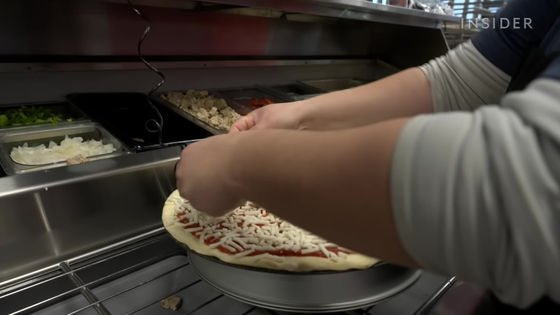How Domino's became the world's largest pizza chain.

Domino's Pizza has achieved significant efficiency by automating most of its manufacturing processes and has grown into the world's largest pizza chain, with Business Insider sharing the voices of people working at Domino's Pizza factories.
Since the start of the COVID-19 pandemic in late 2019, the US food industry has been facing a shortage of 1.2 million workers by the beginning of 2021. In particular, the number of workers leaving warehouse management and delivery jobs has been increasing at a record pace, and Domino's Pizza was one of the companies that suffered from worker exodus. These jobs were physically demanding even though they did not pay well.
So Domino's Pizza introduced a machine to make pizza dough. Domino's Pizza spent $50 million (about 7.87 billion yen) to establish a factory in Indiana, USA.
In this factory, machines measure and stack the pizza dough. Specifically, flour, water, oil, salt, and sugar are fed directly from the storage area into the mixing machine, and about 88,000 pizzas worth of dough are produced per day. Human workers can leave the most physically demanding part of the dough production to the machine and focus on managing the machine.

'Instead of touching the powder, we now press buttons. We just watch and make sure it's working properly. Nine years ago, our team members did this manually. It was a very taxing task for our team members, but now the burden has been greatly reduced, which has helped us to attract more talented people,' said a factory worker.

Domino's Pizza is improving not only manufacturing but also distribution. Pizza dough made at a factory in Indiana is transported to Domino's Pizza stores in the surrounding area, but until now, truck drivers had to both transport and unload the pizzas. However, by establishing a new 'picking team' dedicated to loading and unloading, efficiency has improved and work has become faster. One of the drivers said, 'Our time at the store has been reduced from an hour to 15 minutes.'

The company also puts a lot of effort into training its drivers, setting up a program to gather employees from other divisions of the company and send them to driving school, among other things, in an effort to secure delivery personnel.

Domino's Pizza is not alone in trying this kind of automation. Fast food chains operating in the United States, such as White Castle, Jack in the Box, and KFC, have deployed robots in their brick-and-mortar stores to perform tasks such as cooking chicken. In addition, an increasing number of stores are using AI automated voices to take drive-thru orders.
While there are concerns that robots will take people's jobs, employees say, 'There are jobs that robots can do that are safe for robots to do. For example, stacking boxes can lead to injury. By automating repetitive tasks that are dangerous or simply boring for workers, employees have the opportunity to take on better jobs within the company.' They believe that such efforts should not be demonized.

While manufacturing facilities are becoming more sophisticated, physical stores are not yet fully automated. It is humans who shape the pizza dough, top it with ingredients, bake it, and serve it. However, these are carried out based on Domino's Pizza's slogan 'hand-tossed,' and in this respect, a balance is maintained between machine work and manual work.

Due to the challenges of securing and retaining employees and competing with other delivery companies, the company is also considering using self-driving vehicles for delivery in the future.
Related Posts:







